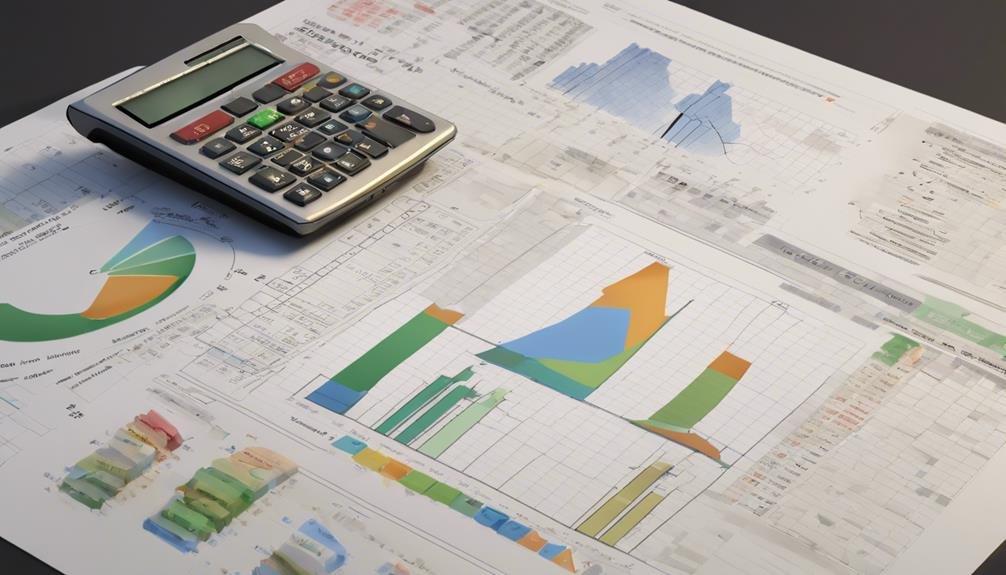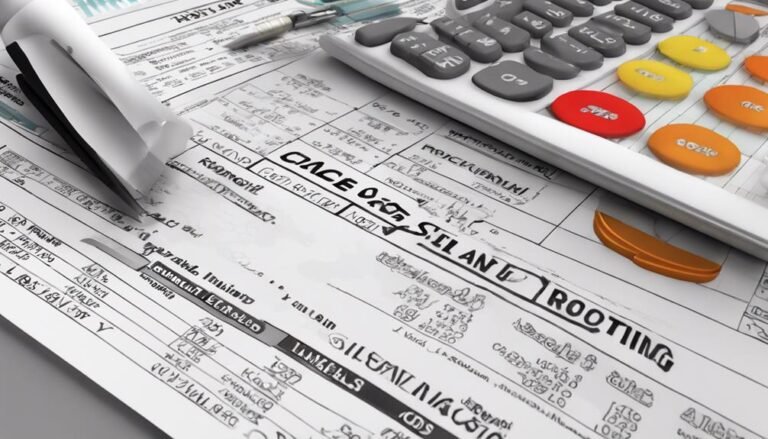Understanding Financial Statements: Balance Sheets, Income Statements, and Cash Flow Statements
To comprehend financial statements like balance sheets, income statements, and cash flow statements is essential in making informed decisions regarding business and investment. Balance sheets show assets, liabilities, and equity, revealing financial health. Income statements outline revenues, expenses, and profitability, indicating performance. Cash flow statements exhibit liquidity and financial stability through operating, investing, and financing activities. Analyzing these statements helps assess risks, profitability, and growth potential. Grasping these fundamentals lays a strong foundation for maneuvering the complex world of finance and making sound choices. Explore further insights by examining each component to gain thorough financial expertise.
Key Takeaways
- Balance sheets display assets, liabilities, equity.
- Income statements show revenues, expenses, profit.
- Cash flow statements reveal operational cash movements.
- Understanding all three statements aids financial analysis.
- Key indicators like ratios assess financial health.
Importance of Financial Statements
Financial statements play an essential role in providing stakeholders with a clear snapshot of a company's financial health and performance. Understanding a company's financial health is vital for effective decision-making. Whether you're an investor, creditor, or manager, analyzing financial statements helps you assess the stability and profitability of a business. By examining key financial indicators such as revenue, expenses, assets, and liabilities, you can make informed decisions about investing, extending credit, or managing operations.
Financial statements aren't just numbers on a page; they're powerful tools that reveal the inner workings of a company. They enable you to track trends, identify areas of strength or weakness, and measure performance against competitors. Armed with this information, you can make strategic decisions that drive growth and profitability. Ultimately, the insights gained from analyzing financial statements empower you to make sound financial decisions that can have a significant impact on the success of a business.
Components of a Balance Sheet
To understand a company's financial position more thoroughly, it's essential to dissect the components of a balance sheet. The balance sheet provides a snapshot of a company's financial health at a specific point in time, showcasing its assets, liabilities, and equity. By analyzing the balance sheet, you can gain insights into the company's liquidity through current ratio analysis, which compares current assets to current liabilities. This analysis aids in evaluating the company's ability to meet short-term obligations.
Furthermore, the balance sheet plays an important role in asset valuation and understanding the company's capital structure. Assets are typically categorized as current assets (such as cash and accounts receivable) or long-term assets (like property and equipment). Liabilities include both current obligations (such as accounts payable) and long-term debts. Equity represents the residual interest in the company's assets after deducting liabilities. Understanding these components allows you to assess the company's financial standing and make informed decisions about investment or partnership opportunities.
Analyzing Assets and Liabilities
When analyzing assets and liabilities, you'll first encounter an overview of the different types of assets present on a balance sheet.
Next, understanding the classification breakdown of liabilities is important for a thorough financial analysis.
Asset Types Overview
Analyzing assets and liabilities involves evaluating the types and values of resources owned and debts owed by an entity. Assets are typically categorized as tangible or intangible. Tangible assets include physical items like property, equipment, and inventory, while intangible assets encompass non-physical assets such as patents, trademarks, and goodwill.
Furthermore, assets are classified as current or non-current based on their liquidity and expected conversion to cash within a year. Current assets are those that are expected to be converted into cash or used up within a year, including cash, accounts receivable, and inventory. On the other hand, non-current assets are long-term investments, property, plant, equipment, and other assets expected to provide economic benefits beyond the current year.
Understanding the distinction between tangible and intangible assets, as well as current and non-current assets, is vital for evaluating an entity's financial health and making informed decisions about its operations and investments.
Liability Classification Breakdown
Understanding the breakdown of liabilities is equally important when evaluating an entity's financial position alongside its assets. Liability classification significance lies in providing insights into the obligations a company owes. By understanding liability categories, implications can be drawn regarding the entity's financial health and risk exposure.
Liabilities are typically classified as current or non-current. Current liabilities are debts due within a year and include accounts payable, short-term loans, and accrued expenses. Non-current liabilities are long-term obligations such as bonds payable and long-term leases. Analyzing the proportion of current liabilities to total liabilities can indicate short-term liquidity and solvency. A high ratio may suggest potential difficulties meeting short-term obligations.
On the other hand, a significant portion of non-current liabilities could signify long-term stability but might also indicate higher leverage and interest payments. Hence, a thorough assessment of the liability breakdown is essential for a detailed evaluation of an entity's financial standing.
Analyzing Balance Sheet Ratios
To evaluate an entity's financial health thoroughly, it is essential to analyze the balance sheet ratios that compare assets and liabilities. Ratio analysis plays a vital role in understanding the strength and stability of a company's financial position. By examining these ratios, you can conduct trend analysis over time and compare them against industry benchmarks to assess performance.
Here is a table illustrating some essential balance sheet ratios for analyzing assets and liabilities:
| Balance Sheet Ratios | Formula |
|---|---|
| Current Ratio | Current Assets / Current Liabilities |
| Quick Ratio | (Current Assets – Inventory) / Current Liabilities |
| Debt-to-Equity Ratio | Total Debt / Shareholders' Equity |
| Debt Ratio | Total Debt / Total Assets |
| Return on Assets (ROA) | Net Income / Total Assets |
Understanding Equity and Debt
Equity and debt represent the two primary sources of financing for a company's operations. Equity involves ownership in the company, with shareholders taking on the risk but also having the potential for higher returns through dividends and capital appreciation. On the other hand, debt represents borrowed funds that need to be repaid with interest, providing leverage to amplify returns but also increasing financial risk.
When comparing Equity vs. Debt, equity tends to be more expensive in the long run as it involves sharing profits with shareholders. Debt, although it comes with the obligation to repay, allows a company to benefit from tax advantages and maintain full ownership control.
Financial leverage strategies involve finding the right balance between equity and debt to optimize a company's capital structure. Too much debt can lead to financial distress, while too much equity dilutes ownership. Companies often use a mix of both to benefit from the advantages each source of financing offers.
Breakdown of an Income Statement
Have you ever wondered how an income statement provides a detailed breakdown of a company's financial performance? An income statement is an important financial document that shows a company's revenues, expenses, and ultimately its profitability over a specific period. One key aspect of an income statement is the calculation of profit margins, which indicate how efficiently a company is generating profit from its operations. Profit margins can be calculated at different levels, such as gross profit margin, operating profit margin, and net profit margin. These margins provide insights into different aspects of a company's performance and help investors assess its financial health.
At the bottom of the income statement lies the net income, also known as the bottom line. Net income represents the total amount of profit or loss a company has generated after accounting for all revenues and expenses. It's a critical metric for investors and stakeholders as it reflects the company's overall financial performance for the period covered by the income statement. Understanding how profit margins and net income are derived from an income statement is essential for evaluating a company's profitability and financial viability.
Revenue, Expenses, and Profit
You need to understand where your revenue comes from and how to manage your expenses efficiently to guarantee a healthy profit margin.
Identifying various revenue sources is essential for optimizing your income streams.
Revenue Sources
When analyzing financial statements, understanding revenue sources is essential for evaluating the financial performance of a company. Revenue is a vital element that directly impacts a company's profitability. By delving into the cost structure analysis and profit margins associated with different revenue streams, you can gain insights into the efficiency and sustainability of the business model.
Market dynamics play a significant role in determining revenue sources. Understanding how the competitive landscape influences sales and pricing strategies is key to identifying opportunities for revenue growth. Companies need to adapt to changing market conditions to maintain and increase their revenue streams.
Analyzing revenue sources allows you to assess the overall health of a company's income streams. By scrutinizing the various sources of revenue and their contribution to the overall financial picture, you can make informed decisions about the company's future direction. This understanding is critical for investors, stakeholders, and management to gauge the company's performance accurately.
Managing Expenses Efficiently
Effective management of expenses is essential for optimizing revenue, controlling costs, and ultimately maximizing profit in a company's financial operations. By cutting costs strategically, you can enhance your bottom line. One key aspect of managing expenses efficiently is budget planning.
Budget planning involves setting financial targets, allocating resources effectively, and monitoring expenditures closely to guarantee they align with the company's goals.
To cut costs effectively, analyze your expenses thoroughly. Identify areas where you can reduce spending without compromising quality or productivity. This could involve renegotiating contracts with suppliers, streamlining processes to eliminate waste, or investing in technologies that automate tasks and lower operational expenses.
Moreover, implementing cost-control measures and regularly reviewing your budget can help you stay on track financially. By actively managing expenses and making informed decisions, you can improve your company's financial health and create a more sustainable business model.
Operating, Investing, and Financing Activities
Operating, investing, and financing activities are the three main categories used to classify the cash flows within a company's financial statements. Understanding these categories is vital for analyzing how a company manages its cash and investments.
Operating activities primarily involve the day-to-day functions of the business, such as sales, purchases, and expenses. Analyzing the cash flows from operating activities provides insight into how efficiently a company manages its cash resources and generates profits.
Investing activities include the buying and selling of long-term assets, such as property, equipment, or investments in other companies. By examining the cash flows from investing activities, you can understand a company's investment strategies and how it allocates resources for future growth.
Financing activities relate to how a company raises capital and pays back its debts. This category includes activities such as issuing stocks, repurchasing shares, obtaining loans, or paying dividends. Analyzing the cash flows from financing activities helps you evaluate how a company funds its operations and expansion plans.
Significance of Cash Flow Statements
To grasp the significance of cash flow statements, one must understand their role in providing a clear picture of a company's financial health and liquidity. Cash flow statements show how changes in balance sheet accounts and income affect cash and cash equivalents. They are important for cash flow forecasting and understanding a company's ability to meet its obligations. Analyzing cash flow statements helps investors assess the sustainability of a company's operations and its capacity to weather financial challenges. Additionally, these statements aid in determining the need for external financing and can influence investment strategies.
| Importance of Cash Flow Statements | Key Points | Implications |
|---|---|---|
| Cash Flow Forecasting | Predict future cash flows based on historical data. | Helps in planning for operational needs and potential investments. |
| Investment Strategies | Evaluate the company's ability to generate cash for growth. | Guides investors in making informed decisions about buying or selling stock. |
| Liquidity Assessment | Assess the company's ability to pay off short-term debts. | Indicates the financial health and stability of the business. |
Monitoring Liquidity and Solvency
Understanding a company's financial health goes beyond analyzing cash flow statements; it involves monitoring liquidity and solvency to assess its ability to meet short-term obligations and long-term financial commitments. Liquidity ratios, such as the current ratio and quick ratio, help evaluate a company's ability to cover immediate liabilities with its current assets. A current ratio above 1 indicates a company can pay off its short-term debts, while the quick ratio provides a more stringent measure by excluding inventory from current assets.
On the other hand, solvency measures like the debt to equity ratio and interest coverage ratio assess a company's long-term financial stability. The debt to equity ratio indicates the proportion of debt used to finance operations compared to shareholders' equity, with lower ratios signaling less financial risk. The interest coverage ratio evaluates a company's ability to make interest payments on outstanding debt, with higher ratios demonstrating better solvency.
Conclusion
To sum up, understanding financial statements is essential for making informed business decisions.
By analyzing balance sheets, income statements, and cash flow statements, you can gain valuable insights into a company's financial health.
So, do you have the knowledge and skills to interpret these statements effectively and drive your business towards success?







